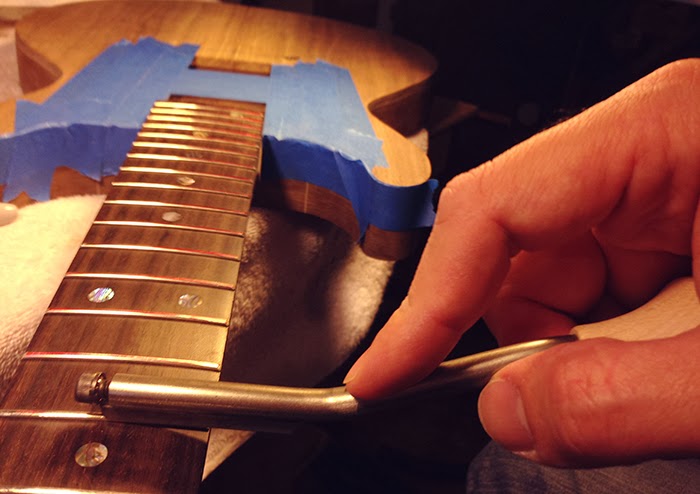I have a few more tasks to complete before I can begin finishing the body. I wanted to get the frets seated and level them first. I had to bend the frets to tighter radius than the fretboard. The fretboard is a 12 inch radius (matching the bridge.) I bent the frets to close to 10 inches.
I over bend the frets because I will be using a hammer to seat them. As the hammer forces the frets into the slots it also flattens the radius.
With all the frets in place its time to clean things up.
First, I remove the overhanging edge pieces with a flat nose wire cutter.
Then I use a fine file, smooth the edges even with the side of the fret board. (I didn't take pictures of this portion of the process. I promise I will do that on my next build.) After the edges are smooth. I turn my file to a 30° angle and run it over the edges again, taking off more of the fret edges. This makes for a smoother playing neck.
Next, it's time to level the fretboard. First I tighten the truss rod slightly (maybe a quarter turn.) I take 320 grit sandpaper on my 12 inch radius fretboard leveling block and level the neck. This flattens the frets taking off any high spots. While doing this I will hold a straight edge to the frets looking for high spots that need more attention.
After I level the fret board it's time to put a crown back on the frets, or round their edges. First, I use a Sharpie marker on the flat edge of all of the frets, this helps me view my progress. (Yes, I did slip and mark up the fretboard at the 24th fret. I'll have to sand that mark off later.)
Next up, I use my fret file. It is a concave file that will round the tops of the flattened frets. By checking regularly I can watch the red marker slowly disappear leaving a round yet rough fret.
Next up I use 400 grit sand paper with a school eraser as a sanding block to take out some of the roughness. I use a metal fret guard to keep from scratching up the fretboard. I will polish the frets after I finish the body.
So now it's time to put everything together and see just what she's going to look like, and test how well she'll play.
I place al of the electronics in the rear cavity. This is a tight fit. On future builds I will route a larger electronics cavity.

The switches and knobs are a little closer than I would have liked. This would have worked out fine, except that I wanted to add two there-way coil tap switches for the pickups. I used two on/off/on DPDT switches for a Series/Single/Parallel wiring for each pickup.
Finally, it's time to string her up and see just how she plays. While most people might find the neck to be a little thick at the nut, I find that I like it that way.
I'll upload a video of me playing the guitar acoustically in a couple of days. It sounds and plays great, even at this rough stage.
I'll upload a video of me playing the guitar acoustically in a couple of days. It sounds and plays great, even at this rough stage.
Next up, I will block sand the body flat, and seal the walnut pores with shellac. I mixed up a nice thick 4 lb. cut of shellac tonight. I had to go back and re-read this post in order to make sure that I had the correct ration of flakes to alcohol - 4 oz of shellac flakes mixed with 8 oz of alcohol.










No comments:
Post a Comment